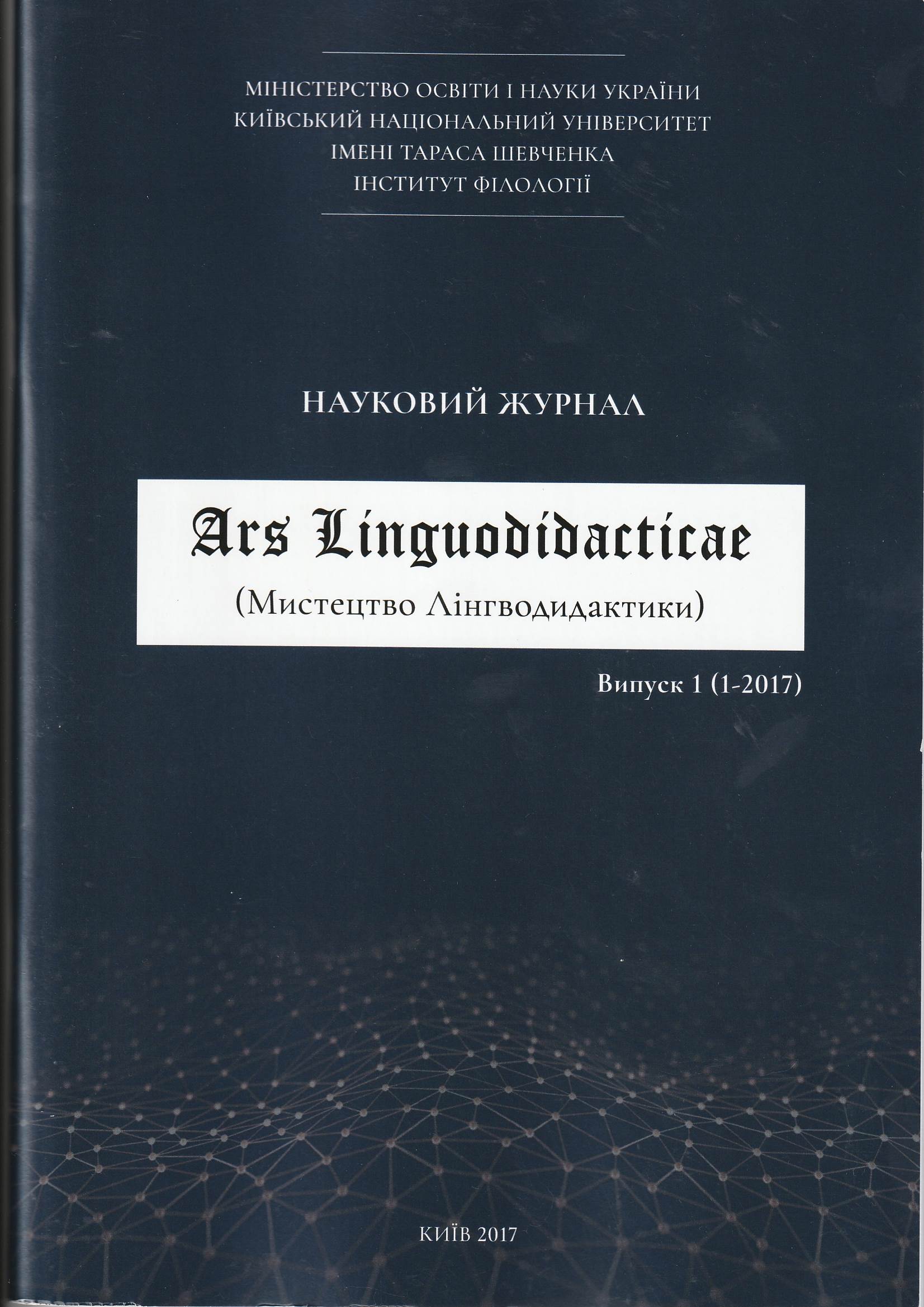TEXTUAL COMPETENCE IN L2 TRANSLATION: THE PROBLEM OF DEFINING
DOI:
https://doi.org/10.17721/2663-0303.2017.1.06Ключові слова:
текстотвірна компетентність у перекладі на іноземну мову, фахова компетентність перекладача, модель компетентностіАнотація
У статті розглядається проблема визначення структури текстотвірної компетентності в перекладі на іноземну мову як складової фахової компетентності перекладача. Запропонована трикомпонентна структура є результатом теоретичного аналізу найбільш поширених моделей фахової компетентності перекладача та робочих навчальних програм з практики перекладу для магістрів кількох вузів України. Розроблена модель пройшла апробацію під час експериментального навчання магістрів-майбутніх перекладачів Інституту філології КНУ імені Тараса Шевченка.
https://doi.org/10.17721/2663-0303.2017.1.06
Посилання
Beeby Lonsdale, A. (1998). Direction of translation (directionality). In: Routledge Encyclopedia of Translation Studies [M. Baker, ed.]. London and New York: Routledge.
Campbell, S. (1991). Towards a model of translation competence. Meta: Translators’ Journal, 36 (2-3), 329–343.
Campbell, S. (1998). Translation into the Second Language. London and New York: Longman.
Chernovatyi, L. (2013). Metodyka vykladannya perekladu yak cpetsialnosti. Vinnytsya: Nova knyga.
European Commission. European Master’s in Translation (EMT) Strategy. (2009). Retrieved from http://europa.eu/dgs/translation/programmesemt/key-documents/emt-strategy/.
García Izquierdo, I. (2000). The Concept of Text Type and its Relevance to Translator Training. Target, 12 (2), 283–295.
Hatim, B., & Mason, I. (1990). Discourse and the Translator. London: Longman.
Kavytska, T. (2015). Formuvannia tekstotvirnoi kompetentnosti maibutnih filologiv u pysmovomu perekladi z ukrainskoi movy na angliysku. Dysertatsia na zdobuttia naukovogo stupenia kandydata pedagogichnyh nauk. Kyiv: KNU.
Kelly, D. (2000). Diversity in unity. In: Translation into non-mother tongues in translatortraining in Spain, (pp. 185-191). Tübingen: Stauffenburg Verlag.
Kelly, D. (2002). Un modelo de competency traductora: bases para el diseño curricular. Puentes. Hacia nuevas investigaciones en la mediación intercultural, 1, 9-20. Retrieved from: http://www.ugr.es/~greti/puentes/puentes1/02%20Kelly.pdf
Kiraly, D. (2000). Translation into a non-mother tongue: From collaboration to competence. In: Translation into Non-Mother Tongues in Professional Practice and Training, (pp.117–123). Tübingen: Stauffenburg Verlag.
Komissarov V. (1997). Teoreticheskie osnovy metodiki obucheniya perevodu. M: Izdatelstvo REMA.
Kussmaul, P. (1995). Training the Translator. Amsterdam: John Benjamins Publishing.
Mackenzie, R. (2000). Resource research strategies: A key factor in teaching translation into the non-mother tongue. In Translation into Non-Mother Tongues in Professional Practice and Training, (pp. 125–131). Tübingen: Stauffenburg Verlag.
Montalt Ressurrecció, V, Ezpeleta Piorno, P García Izquierdo I. (2008). The Acquisition of Translation Competence through Textual Genre. Translation Journal, 12 (4).
Neubert, A., Shreve G. (1992). Translation as Text. Kent: Kent State University Press.
Neubert, A., Schäffner, C.& Adab, B. (Eds.), (2000). Competence in Language, in Languages, and in Translation. In Developing Translation Competence, (pp. 3–18). Amsterdam: John Benjamins.
Neunzig, W. (2003). Tecnologías de la información y traducción especializada inversa. In La direccionalidad en traducción e interpretación. Perspectivas teóricas, profesionales y didácticas. [D. Kelly, A. Martin, M. L. Nobs, D. Sánchez and C. Way (eds.)]. Granada: Editorial Atrio.
PACTE, (2003). Alves, F. (Ed.). Building a Translation Competence Model. In Triangulating Translation: Perspectives in Process Oriented Research, (pp. 43-66). Amsterdam: John Benjamins.
Pavlović, N. (2007). Directionality in collaborative translation process: dissertation presented for the award of Doctor of Philosophy, Universitat Rovira I Virgili.
Schäffner, C. (2000). Schäffner, C. & Beverly, A. (Eds). Running before Walking? Designing a Translation Programme at Undergraduate Level (pp.143–156).In Developing Translation Competence. Amsterdam and Philadelphia: John Benjamin.
Séguinot, C. (1982). The Editing Function of Translation. In: Bulletin of the Canadian Association of Applied Linguistics, 1, Vol. 4.
Stein, G. (1990). From the bilingual to the monolingual dictionary. In BudaLEX ‘88 Proceedings: Papers from the EURALEX Third International Congress, Budapest, 4-9 September 1988. Budapest, Akademiai Kiadу.
Stewart, D. (2008). Vocational translation training into a foreign language. Intralinea online translation journal, 10, 1–17.
Teubert, W. Comparable or parallel corpora? Retrieved from: www.ijl.Oxfordjournals.org
##submission.downloads##
Опубліковано
Як цитувати
Номер
Розділ
Ліцензія
Авторське право (c) 2017 Тамара Кавицька

Ця робота ліцензується відповідно до Creative Commons Attribution-ShareAlike 4.0 International License.
Ця робота ліцензується відповідно до Creative Commons Attribution-NonCommercial 4.0 International License.
Політика охорони авторських прав відповідно до умов ліцензії: Creative Commons Attribution-NonCommercial (Атрибуція-Некомерційне використання) 4.0 Міжнародна (CC BY-NC 4.0).
Автори, що публікують свої статті в журналі "Ars Linguodidacticae" (журналі відкритого доступу) зберігають за собою такі права:
- Автори зберігають за собою права на авторство своєї статті та надають журналу "Ars Linguodidacticae" право першої публікації рукопису своєї статті на умовах ліцензії Creative Commons (CC BY-NC 4.0) Attribution License, яка дозволяє іншим особам вільно розповсюджувати опубліковану роботу з обов'язковим посиланням на автора оригінальної роботи та першу оригінальну публікацію в журналі "Ars Linguodidacticae". Інформація про збереження права на авторство надається на титульній сторінці статті.
- Автори зберігають за собою право укладати окремі угоди на неексклюзивне розповсюдження своєї статті у тому вигляді, в якому вона була опублікована в журналі "Ars Linguodidacticae" (наприклад, розміщувати статтю в електронних бібліотеках, архівах та каталогах або публікувати у складі інститутських збірників та монографій), за умови обов'язкового повного посилання на першу оригінальну публікацію в журналі "Ars Linguodidacticae".
- Політика журналу "Ars Linguodidacticae" дає змогу та заохочує розміщення авторами в мережі Інтернет (наприклад в інститутському репозитарії або на персональному сайті) рукопису роботи як до її подання до редакції, так і під час її редакційного опрацювання, оскільки це сприяє продуктивній науковій дискусії та позитивно позначається на оперативності й динаміці цитування статті.
Редакція журналу зберігає за собою видавничі права на:
- зверстані оригінали статей та весь номер журналу;
- оформлення журналу, а також оригінальні ілюстративні та додаткові матеріали;
- репринтні перевидання журналу в друкованому та електронному вигляді.
Політика охорони авторських прав провадиться відповідно до умов ліцензії: Creative Commons Attribution-NonCommercial (Атрибуція-Некомерційне використання) 4.0 Міжнародна (CC BY-NC 4.0).
Для отримання додаткової інформації, будь ласка, прочитайте повний текст Публічної ліцензії CC BY-NC 4.0
Creative Commons Attribution-NonCommercial 4.0 International License.


